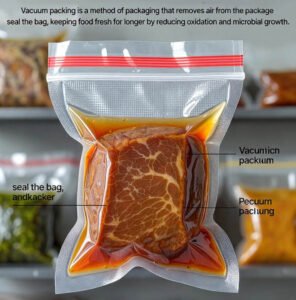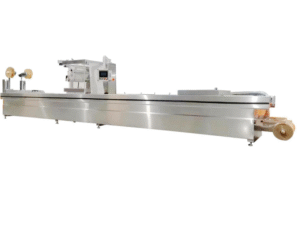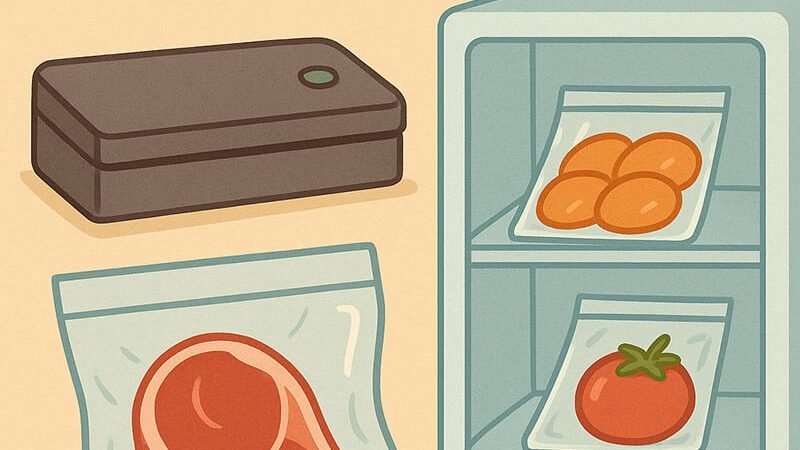What is Food Vacuum Packing?
Table of Contents
Introduction
Food vacuum packing is a preservation method that removes air from packaging before sealing, creating an oxygen-free environment that significantly extends the shelf life of food products. This technology has revolutionized both commercial food processing and home food storage, offering a simple yet highly effective solution to one of humanity’s oldest challenges: keeping food fresh for extended periods.
The process of food vacuum packing involves placing food items in specially designed plastic bags or containers, removing the air using a vacuum pump, and then heat-sealing the package to maintain the vacuum. By eliminating oxygen exposure, this method dramatically slows down the deterioration processes that cause food spoilage, including oxidation, bacterial growth, and freezer burn.

How Food Vacuum Packing Works
The science behind food vacuum packing is straightforward yet remarkably effective. When food is exposed to air, several degradation processes occur simultaneously. Oxygen promotes the growth of aerobic bacteria and molds, causes oxidation that leads to discoloration and rancidity, and facilitates enzymatic reactions that break down nutrients and alter texture.
A vacuum packing system addresses these issues through a multi-step process. First, the food item is placed inside a specialized vacuum bag made from multilayer plastic films designed to prevent air penetration. The open end of the bag is then positioned in the vacuum chamber or on the sealing bar of the machine. When activated, the vacuum pump extracts air from the bag, creating negative pressure that removes approximately ninety-nine percent of the oxygen. Finally, a heat-sealing element fuses the bag’s opening, creating an airtight seal that maintains the vacuum environment.
Modern food vacuum packing machines can complete this entire process in seconds, making it practical for both high-volume commercial operations and everyday home use. The precision of contemporary systems ensures consistent results, with digital controls allowing users to adjust vacuum strength and sealing time based on the specific food being packaged.
Food Preservation Benefits
The preservation capabilities of food vacuum packing are impressive and well-documented. Fresh meat, which typically lasts only a few days in conventional refrigeration, can remain fresh for up to two weeks when vacuum-packed in the refrigerator. In freezer storage, vacuum-packed meat maintains its quality for two to three years compared to just six months with traditional freezer storage methods.
Vegetables and fruits also benefit significantly from vacuum packing, though the approach differs slightly. While some produce releases gases that can compromise vacuum seals, proper preparation and blanching techniques allow most vegetables to be successfully vacuum-packed, extending their freezer life from eight months to well over two years.
Dried goods such as coffee, nuts, flour, and grains experience remarkable shelf-life extensions through food vacuum packing. These products, which can quickly go stale or rancid when exposed to air, maintain their freshness and flavor for months or even years when properly vacuum-sealed. This makes vacuum packing particularly valuable for bulk purchasing and long-term pantry storage.
Types of Vacuum Packing Systems
The market offers several types of food vacuum packing systems, each designed for specific applications and user needs. External vacuum sealers represent the most common type for home use. These compact, affordable machines sit on countertops and work by placing the open end of a specially textured bag into the machine, which then extracts air and seals the bag. They’re ideal for occasional use and smaller quantities of food.
Chamber vacuum sealers operate differently and offer advantages for both commercial operations and serious home users. These systems place the entire bag inside a chamber, evacuate air from both the chamber and the bag simultaneously, then seal the bag before releasing the vacuum. This approach allows for the packaging of liquids and moist foods without the risk of liquid being drawn into the pump, making it far more versatile than external sealers.
Commercial food vacuum packing systems take functionality to industrial levels, featuring heavy-duty construction, high-capacity pumps, and automated controls designed for continuous operation. These machines can process hundreds of packages per hour and often include specialized features like gas flushing, which replaces oxygen with inert gases for specific preservation requirements.

Common Applications
Food vacuum packing finds applications across numerous contexts, from restaurant kitchens to home pantries. In commercial food service, vacuum packing enables sous vide cooking, a technique where vacuum-sealed food is cooked in precisely controlled water baths, resulting in exceptional texture and flavor retention. Restaurants also use vacuum packing for portion control, prep work organization, and extending the usability of expensive ingredients.
Retail food packaging heavily relies on vacuum technology. Walk through any supermarket and you’ll encounter vacuum-packed products throughout: deli meats, cheese blocks, smoked fish, fresh pasta, and pre-marinated proteins all utilize this preservation method. The technology allows manufacturers to distribute products over greater distances and reduces waste by extending sell-by dates.
Home users have embraced food vacuum packing for meal planning, bulk shopping, and seasonal food preservation. Hunters and fishers vacuum-pack their harvests to maintain quality through the off-season. Gardeners preserve their summer bounty for winter enjoyment. Budget-conscious families buy in bulk during sales and vacuum-pack portions for future use, reducing both food waste and grocery expenses.
Key Advantages of Food Vacuum Packing
Beyond extended shelf life, food vacuum packing offers numerous practical benefits. Space efficiency ranks high among these advantages. Vacuum-packed items compress significantly, allowing more food to fit in refrigerators and freezers. This compact storage is particularly valuable for those with limited space or who prefer to stock up during sales.
Flavor and nutrient preservation represent another crucial benefit. By preventing oxidation and limiting microbial activity, vacuum packing maintains food quality at levels impossible with conventional storage methods. Delicate herbs retain their vibrant colors and aromatic compounds, meats maintain their natural juices and tenderness, and nuts stay crisp rather than turning rancid.
The prevention of freezer burn alone justifies food vacuum packing for many users. Freezer burn occurs when air circulates around frozen food, causing dehydration and oxidation that create dry, discolored patches. The airtight environment of vacuum packaging eliminates this problem entirely, ensuring that food emerges from the freezer months later looking and tasting as good as the day it was sealed.
Economic benefits accumulate quickly with regular use. Reduced food waste translates directly to money saved, as does the ability to buy in bulk when prices are favorable. For businesses, vacuum packing reduces spoilage losses and allows for better inventory management and more efficient use of storage space.
Best Practices and Tips
Maximizing the benefits of food vacuum packing requires attention to proper techniques. Food preparation makes a significant difference in outcomes. Meats should be patted dry before vacuum packing to ensure a good seal and prevent bacterial growth. Vegetables benefit from blanching before freezing, which deactivates enzymes that can cause deterioration even in vacuum-sealed packages.
Bag selection impacts both sealing success and long-term storage effectiveness. Quality bags specifically designed for vacuum packing feature textured surfaces that facilitate air removal and multiple layers that prevent oxygen permeation. While premium bags cost more upfront, they provide superior protection and are essential for long-term storage.
When using food vacuum packing for liquids or moist foods, several strategies help achieve successful results. Freezing liquids partially before vacuum packing prevents them from being drawn into the sealer. Placing a folded paper towel at the bag opening absorbs excess moisture during sealing. Chamber vacuum sealers eliminate these concerns entirely, handling moist foods without special preparation.
Proper labeling and organization enhance the utility of vacuum-packed foods. Date labels ensure rotation of stored items, while content descriptions prevent the frustration of thawing mystery packages. Many users develop organizational systems, dedicating freezer areas to specific categories of vacuum-packed items for easy retrieval.
Conclusion
Food vacuum packing represents a powerful tool for anyone seeking to preserve food quality, reduce waste, and optimize storage efficiency. Whether you’re a commercial food processor managing inventory and shelf life, a restaurant chef executing sous vide techniques and prep work, or a home cook trying to make the most of your grocery budget and freezer space, vacuum packing technology offers tangible benefits.
The versatility of food vacuum packing continues to expand as technology advances and new applications emerge. From emergency preparedness supplies to camping trip provisions, from preserving garden harvests to protecting valuable ingredients, vacuum packing has proven itself indispensable across diverse contexts.
As food costs rise and sustainability concerns grow, the ability to extend food life and reduce waste becomes increasingly valuable. Food vacuum packing delivers on both counts while maintaining the quality and flavor that make eating enjoyable. For those yet to explore this technology, the investment in a quality vacuum sealer quickly pays dividends in preserved food, saved money, and enhanced culinary possibilities.
